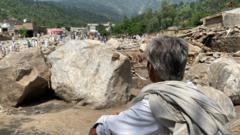In a tragic turn of events, northern Pakistan is grappling with the aftermath of catastrophic floods that have resulted in at least 314 deaths and over 156 injuries. The floods surged through the picturesque village of Bishnoi, sweeping away homes and obliterating the livelihoods of its residents within moments of rainfall that began on August 15.
Local eyewitnesses recounted that the sudden torrent carried debris, uprooting trees and destroying structures. Rescue efforts have been severely hindered by the extent of the destruction; with many homes buried beneath rubble, families are scouring the debris hoping to find missing loved ones. One resident, Israr Khan, lamented, "There is a house under every stone. People try to look under these rocks to see if they can find someone."
The province of Khyber Pakhtunkhwa has borne the brunt of this natural disaster, with Buner district—the hardest hit—reporting 217 fatalities according to the Provincial Disaster Management Authority (PDMA). Residents shared harrowing stories, including families caught unaware in a home preparing for a wedding.
The monsoon season, crucial for South Asia's water supply, is usually marked by heavy rainfall from June to September, often leading to landslides and flooding. This year alone, more than 507 people have died in Pakistan due to rain-related incidents. The agricultural community, including Bishnoi's population primarily engaged in farming, is facing severe losses, with around 50% of local homes now uninhabitable.
Experts warn that climate change effects, such as glacial melting, contribute to heightened risks, as evidenced by ongoing research into the causes of the floods. These changes not only affect the geography but have a profound impact on the lives of already vulnerable communities in the region.
Meanwhile, provincial and federal authorities have declared several areas as disaster zones, and weather forecasts suggest continued heavy rainfall until August 21. Amidst despair, the community's resilience has emerged, with local and national organizations mobilizing to provide relief, set up medical camps, and assist in the recovery operations. Volunteers from nearby areas have also joined efforts to support those affected.
In one instance of rapid response, Saeed Ahmad, the principal of a local school in nearby Swat Valley, successfully evacuated nearly 900 students just moments before floodwaters engulfed the building. This timely evacuation is a rare success story, contrasting with the tragic loss reported by Abdul Salam, who recounted the sorrow of losing his entire family to the raging waters.
As survivors sift through the ruins of their homes, the grim search for the missing continues. Relief workers and concerned citizens alike are joining forces to aid in clean-up and recovery efforts, emphasizing the urgent need for both immediate aid and long-term strategies to mitigate the impacts of climate change on vulnerable populations in Pakistan's mountainous north.




















